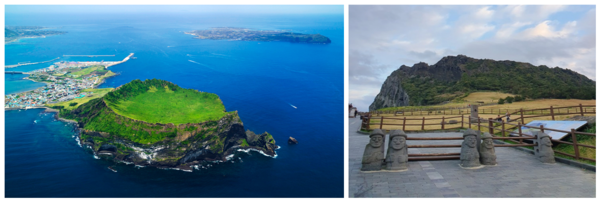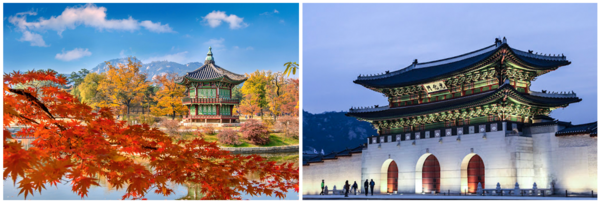The pandemic has posed indefinite obstacles to countless groups in our society, including avid travelers. Due to canceled holiday plans and reluctance to leave the safety provided by our homes, the footsteps of tourists have since diminished, leaving numerous travel attractions abandoned. To reflect and remind ourselves of the marvels our culture embodies, we present you with a valuable list of five diverse landmarks to visit in Korea — to help you construct your post-COVID-19 travel plans!
Seongsan Ilchulbong Peak (“Sunrise Peak”), Jeju Island
This 5,000-year-old tuff cone crater remains the most artistic evidence of an ancient volcanic eruption on Jeju Island. Armored by jagged rocks, the underwater “castle” has risen to 128 m above the sea surface since. Crowned as a UNESCO World Natural Heritage Site and one of the most memorable scenic destinations in Korea, it nurtures an extensive ecosystem of rare vegetation and wild animals. With an entry fee of 2,000 KRW and a 45-minute hike, one can reach the summit and immediately gain a new perspective — a panoramic view that includes the cow-shaped Udo Island, the iconic Hallasan, and an indefinitely beautiful sunrise. The steep slopes may pose minor hardships to the traveler; however, one can always rely on the carefully constructed hiking pathways and the rest stops to relieve their climb!

Andong Hahoe Folk Village, Andong
Standing as a hometown to generations of the Pungsan Ryu clan and ancient scholars for over 600 years, the Andong Hahoe Folk Village is recognized as a “living, breathing piece of history”. As such, it displays the most intricate conservation of Korean culture. A 1.2 km bus ride will guide one to the innermost Andong village, where one can “live” the Joseon dynasty — with the tranquil atmosphere, thatched-roofed houses, and cultural activities such as mask dances and Jwibulnori (a traditional game). Some buildings are not open for viewing because residents inhabit them even today. However, this renders the experience all the more enchanting and authentic. The Andong Hahoe Folk Village is constantly sought by both Korean and foreign tourists, notably including Queen Elizabeth II and former US President George Bush.

Five Grand Palaces, Seoul
Seoul is not only home to modern skyscrapers and city centers but also five grand palaces — truly a must-see for an enriching and royal Korean experience! Constructed in 1395 by King Taejo, Gyeongbokgung is the primary and most extensive royal palace that marks the start of the Joseon Dynasty. Changdeokgung, Changgyeonggung, Deoksugung, and Gyeonghuigung are slightly smaller and more modern, established and temporarily inhabited by various kings throughout history. Despite their severe destruction during the Japanese Occupation, all five Grand Palaces have been elegantly reconstructed after South Korean independence. The grandeur of the architecture blends harmoniously with the natural topography — the autumn scenery is especially captivating. Wearing a hanbok while touring the palaces will allow one to not only enter free of charge but also cherish Korean culture further and create valuable memories!

Imjingak Resort, Paju
Unwittingly engulfed by the Cold War and torn at the 38th parallel, Korea holds a lengthy and tumultuous history of conflict. The Imjingak Resort, located 7 km from the Korean Demilitarized Zone (DMZ), embodies the lasting aftermath of the Korean War. The numerous war-related artifacts such as the Freedom Bridge, and the memorial hall within the resort resonate the yearning for peace and connection. Inside the Pyeonghwa-Nuri “Unification” Park, the Hill of Music and the Pinwheel Park are north-bound, standing in remembrance for war casualties and divided families. Imjingak Resort might be less well-known among foreign tourists; nevertheless, it will make a meaningful addition to one’s historical knowledge and perspective. The next time you decide to tour the DMZ, do not forget the Imjingak Resort!

Bulguksa Temple and Seokguram Grotto, Gyeong-ju
Established in the 8th century during the golden age of East Asian art, the Bulguksa temple is one of the oldest and greatest national treasures. The landmark has been a UNESCO Cultural Heritage Site since 1995. Intricately constructed to symbolize the land of Buddha and the concept of paradise, the temple embodies strength and spiritual energy. On the east side of Mount Tohamsan lies Seokguram Grotto, a cave shrine built as a part of the sanctuary at Bulguksa temple. Inside, a monumental statue of Buddha meditatively gazes at the sea. One can truly appreciate the architectural elegance and innovation of the Silla dynasty that no photo can fully contain. Whether young or old, in families or alone, Bulguksa and Seokguram provide a meaningful journey into the past and the sacred realm.

The marvels of South Korea embody a delightful harmony of natural beauty, cultural value, and historical meaning. As you explore South Korea, you will truly appreciate the distinct local “flavors” that the various regions of Korea provide. Such will ever contribute to a purposeful and memorable travel experience.

